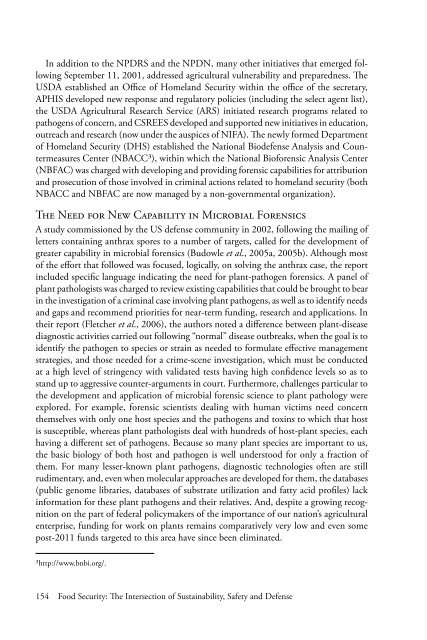Food Security - National Agricultural Biotechnology Council ...
Food Security - National Agricultural Biotechnology Council ...
Food Security - National Agricultural Biotechnology Council ...
- No tags were found...
Create successful ePaper yourself
Turn your PDF publications into a flip-book with our unique Google optimized e-Paper software.
In addition to the NPDRS and the NPDN, many other initiatives that emerged followingSeptember 11, 2001, addressed agricultural vulnerability and preparedness. TheUSDA established an Office of Homeland <strong>Security</strong> within the office of the secretary,APHIS developed new response and regulatory policies (including the select agent list),the USDA <strong>Agricultural</strong> Research Service (ARS) initiated research programs related topathogens of concern, and CSREES developed and supported new initiatives in education,outreach and research (now under the auspices of NIFA). The newly formed Departmentof Homeland <strong>Security</strong> (DHS) established the <strong>National</strong> Biodefense Analysis and CountermeasuresCenter (NBACC3), within which the <strong>National</strong> Bioforensic Analysis Center(NBFAC) was charged with developing and providing forensic capabilities for attributionand prosecution of those involved in criminal actions related to homeland security (bothNBACC and NBFAC are now managed by a non-governmental organization).The Need for New Capability in Microbial ForensicsA study commissioned by the US defense community in 2002, following the mailing ofletters containing anthrax spores to a number of targets, called for the development ofgreater capability in microbial forensics (Budowle et al., 2005a, 2005b). Although mostof the effort that followed was focused, logically, on solving the anthrax case, the reportincluded specific language indicating the need for plant-pathogen forensics. A panel ofplant pathologists was charged to review existing capabilities that could be brought to bearin the investigation of a criminal case involving plant pathogens, as well as to identify needsand gaps and recommend priorities for near-term funding, research and applications. Intheir report (Fletcher et al., 2006), the authors noted a difference between plant-diseasediagnostic activities carried out following “normal” disease outbreaks, when the goal is toidentify the pathogen to species or strain as needed to formulate effective managementstrategies, and those needed for a crime-scene investigation, which must be conductedat a high level of stringency with validated tests having high confidence levels so as tostand up to aggressive counter-arguments in court. Furthermore, challenges particular tothe development and application of microbial forensic science to plant pathology wereexplored. For example, forensic scientists dealing with human victims need concernthemselves with only one host species and the pathogens and toxins to which that hostis susceptible, whereas plant pathologists deal with hundreds of host-plant species, eachhaving a different set of pathogens. Because so many plant species are important to us,the basic biology of both host and pathogen is well understood for only a fraction ofthem. For many lesser-known plant pathogens, diagnostic technologies often are stillrudimentary, and, even when molecular approaches are developed for them, the databases(public genome libraries, databases of substrate utilization and fatty acid profiles) lackinformation for these plant pathogens and their relatives. And, despite a growing recognitionon the part of federal policymakers of the importance of our nation’s agriculturalenterprise, funding for work on plants remains comparatively very low and even somepost-2011 funds targeted to this area have since been eliminated.3http://www.bnbi.org/.154 <strong>Food</strong> <strong>Security</strong>: The Intersection of Sustainability, Safety and Defense















